|
Tafuria maculata (HEWITSON) - °\´³Âù§À¦Ç½º - Spotted Royal
| Introduction | The Butterfly | Courtship and Mating | Ovipositing behaviour and mortality | Voltinism | Food plant | Conservation | Early stages | Acknowledgment | Reference | Plates |
Reprint from FUTAO No.33 Entomological reports of FUTAO-KAI
C/O Hiroto HANAFUSA - 688-2, Tashima, Tottori-shi, Tottori, 680-0804 JAPAN / March 30, 2000
A brief note on the life history of Tajuria maculata (HEWITSON) Lepidoptera, Lycaenidae in Hong Kong, PRC
James J. YOUNG - 20/F Tung Wai Comm. Bldg., 109-111 Gloucester Road, Wanchai, Hong Kong, P.R.C.
Abstract
A summary of the life history of Tajuria maculata (Lycaenidae: subfamily-Theclinae) is described and illustrated by colour photographs.
Key Words
Lycaenidae, Tajuria maculata, life history, Hong Kong, P.R.C.
Introduction
The distribution of Tajuria maculata (HEWITSON) covers a vast area from Nepal, NE India, Burma, Thailand, Yunnan, Guangxi, Hainan and Guangdong, south to Malay Peninsula, Sumatra and Borneo (BASCOMBE, 1999). No subspecies is recognized (D'BRERA 1984).
The Butterfly
Tajuria maculata is a medium-sized Lycaenid. Wings of male have slightly shiny blue centre, suffused with white towards the edge, and enclosed all round with a black margin. In females, most of the shiny blue is replaced by white, so that only a small amount of blues remains in the base of each wing. The underside of both sexes is white, covered with irregular black spots. There are two prominent black spots at each hindwing tornus, adjacent to the two tails. Females are generally larger and broader than males. Seasonal forms do appear to exist (BASCOMBE 1999).
Its flight is swift and erratic. It tends to fly around its host plant and will not wander far. It usually settles on the upperside of leaves and is usually easy to reach. There was no sighting records of the butterfly feeding at flowers or at puddles.
The butterfly is only recorded in two separate locations in Hong Kong in recent years, namely in Pok Fu Lam on the Hong Kong Island ( S. Murakami per p. com.) and Tai Po Kau in the New Territories. This paper presents the result of the only one time rearing of Tajuria maculata from eggs collected by an ovipositing female from Tai Po Kau under indoor controlled conditions with room temperature at around 26°C.
Courtship and Mating
No courtship behaviour has been observed. The butterfly seems to show hill topping behaviour, as 3 male specimens (dry season form) had been collected by W. F. Palmer in April 1974, at the top of Kwun Yam Shan, Kardoorie Farm, Tai Po (BASCOMBE 1999), a place notable for hill topping.
Ovipositing behaviour and mortality
A female was found laying eggs along the entire edge of a leaf blade of Macrosolen cochinchinensis (LOUR.) VAN TIEGH at Tai Po Kau Nature Reserves, Tai Po, New Territories on 27th July 1999 at around 12.30p.m. This peculiar act of laying eggs in a row is not what one would expect, instead of the usual singly laid white or yellowish Lycaenid egg, glued to the underside of leaves or at leaf stalks of a host plant, just like other closely related Hong Kong species in the subfamily Theclinae, e.g. Creon cleobis (GODART), Pratapa deva (MOORE) and Tajuria cippus (FABRICIUS). Without actually seeing the eggs being laid, these will surely be assumed to be eggs laid by sawflies species (family Tenthredinidae), which have similar habit of laying eggs along the edge of leaf blades. It settled near the edge of a host plant leaf blade, bent its abdomen and laid a row of eggs along it. The butterfly was not easily frightened away and ignored close observation. From the look of the beak mark at the hindwing (photograph 1), this female was probably injured or exhausted. About 90 eggs were found around the entire leaf blade. It stayed on the leaf for over 10 minutes before it was captured and caged for more eggs, assuming it would live only a day or two more. On searching all other mistletoes in the vicinity, another batch of 90 eggs was found.
The caged female laid another 42 eggs before it died in the next morning. Totally, it seemed to have laid over 220 eggs. On returning to the same spot in the following week, all eggs had hatched. The larvae were feeding gregariously together and were skimming off the top layers of the leaf on which they were laid (photograph 4).
Returning on the second week, all larvae disappeared, presumably fallen prey to predators. It was a sad story.
Voltinism
The butterfly is multivoltine. The butterfly is found as early as April (WALTHEW 1997). One or two odd sightings have been recorded in June and August and a batch of eggs was also found on 4th September 1999 in the same location in Tai Po Kau. No other record of sightings has been made, as the butterfly is extremely rare. So far the butterfly is only sighted in one particular spot in Tai Po Kau even though mistletoes are found throughout the Reserves.
Food plant The host plant is Macrosolen cochinchinensis (LOUR.) VAN TIEGH. During rearing, Taxillus chinensis (DC.) DANSER was given to the larvae along with Macrosolen cochinchinensis. The larvae immediately switched to Taxillus chinensis as their staple food. It appears that both plants are used as their hosts, but Taxillus chinensis is much preferred
Conservation
The butterfly is extremely rare even though there is an abundance supply of its host plants throughout Hong Kong. It appears that the butterfly is subjected to a very high level of predatory attacks as a whole colony of larvae disappeared completely within two weeks of hatching. The butterfly needs to be protected and the habitat in Tai Po Kau needs to be preserved.
Early stages
Egg: The egg is reddish yellow when freshly laid, turning blackish yellow before the larva emerges from its eggshell. It looks somewhat like the shape of a Chinese pork bun in miniature. It is non-sculptured and has no pits, flattened on the bottom, with a depression or micropyle on the top. It measures about 0.7mm in length and 0.5mm in height. The caterpillar will emerge after 3 days.
Larva: The 1st instar has a slender elongated body, ridged and studded with, simple hair-like setae on white bases. It tapers towards the end of the abdomen. It is pale yellowish in colour and has a retractable forehead with black prothorax.
The larva will only consume that part of its eggshell for the purpose of exit and will feed on the epidermis of the leaf. The larvae of Tajuria maculata are gregarious. They will feed and stay together on the same leaf until they have finished the entire leaf before moving onto the next leaf. The larvae will always stay together on the upperside of the leaf. The 1st instar lasts for 6 days. It measures from about 1.5mm to 4.0mm. The larvae will become much broader and the white secondary setae are more prominent just before the next moulting. The larvae will consume its skin but not its head capsule after each moulting. The 2nd and 3rd instars take 3 days each to complete and measure up to 7mm and 1.4cm respectively. The long bristle-like simple seta shorten and disappear while the white secondary setal bases become more swollen and grow upwards. The head capsule and the prothorax turn blackish and the larvae more yellowish in colour. They will still stay together and their appetite increase tremendously. Two 3rd instar larvae can easily gobble up a whole leaf a day.
The 4th or final instar lasts for 6 days before pupation. The larva is reddish in colour with bright yellowish raised setae. These brightly coloured raised setae may represent warning colours to their potential predators. The larva will stay on the upperside of the leaf and measures from 1.4cm to 1.8cm. The larvae do not seem to have any association with ants as there were no ants present on the host plant during various visits to their habitat at Tai Po Kau, particularly during the two weeks of observation of the colony produced by the ovipositing female observed on 27th July, 1999.
Pupa: The larva will remain motionless for about 1 to 2 days and its body will begin to contract before pupation. In captivity, the larva pupated on the upper surface of the leaf. A large portion of the end of its abdomen will attach itself to the leaf and eventually secure the pupa. The pupa is brownish in colour. Another surprise again, some black longitudinal spots, or more exactly, slightly hollow pits, 4 in total, appear on the dorsal part of the pupa in about half an hour right after pupation. 2 small pits are also found on each side near the fold of the wing section of the pupal case. At first instance, the appearance of these pits was assumed to be sign of malnutrition and breakdown of chitinous material essential for the formation of the pupal case. All reared pupae turned out to have pits. It was assumed that all pupae will die of malnutrition. Similar pits had never been encountered before in any other butterfly species reared by the author so far. The pupa measures from 1.1cm to 1.2cm with females tending to be slightly longer in length. A day of rejoice returned when the adults emerged successfully from their pupal cases on the 11th day after pupation. They all emerged in the early hours of the morning. The complete cycle from egg to adult lasts for 22 days. The function of these pupal pits remains to be elucidated.
Acknowledgment
I thank David Yiau for informing me his sighting of the butterfly at Tai Po Kau in June 1997, Dr David Tang for reviewing my paper and the staff at the Hong Kong Herbarium for their kind assistance.
Reference
1, BASCOMBE M.J., JOHNSTON G. & BASCOMBE F.S., 1999 The Butterflies of Hong Kong, Academic Press, London UK. Page 223.
2, CHEN F.H., 1987 Flora of Guangdong, Volume I, Guangdong Science and Technology Press, China pages 215 to 228.
3, D'BRERA B., 1984 Butterflies of the Oriental Region Part III. Hill House, Australia, page 613.
4, HONG KONG HERBARIUM, 1993 Checklist of Hong Kong Plants. Agriculture and Fisheries Department, Bulletin No. 1, 1993, page 50.
5, WALTHEW G, . 1997 The Status and Flight Periods of Hong Kong Butterflies, Newsletter of the Kadoorie Agricultural Research Centre & Hong Kong University July 1997 issue.
Plates
The life history of Tajuria maculata (HEWITSON)
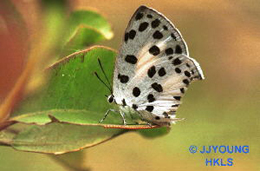 |
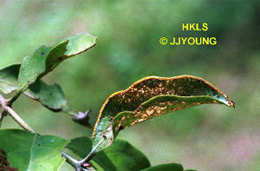 |
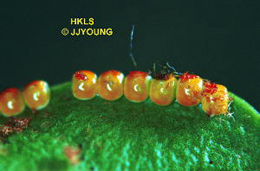 |
| 1, ovipositing adult female at rest with row of eggs in view ? 18/7/99 Tai Po Kau |
2, eggs-laid in row along leaf edge |
3, eggs - row of empty shell on leaf edge of natural host |
|
|
|
|
|
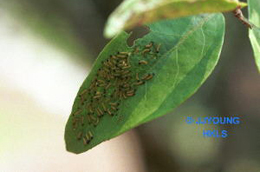
|

|
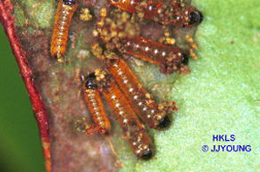
|
| 4, 1st instar larvae - newly emerged |
5, 1st instar larvae ? gregarious, skimming off the leaf epidermis of its natural host |
6, 1st instar larvae -top view |
|
|
|
|
|
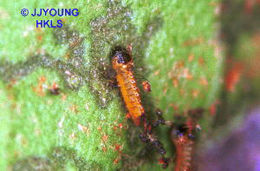
|

|
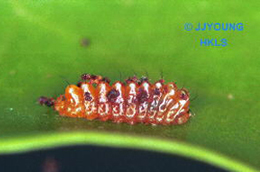
|
| 7, 1st instar larva - side view |
8, 1st instar larvae - before moulting |
9, 1st instar larva - before moulting, side view |
|
|
|
|
|
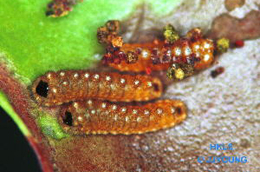
|
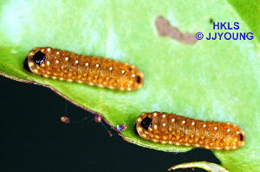
|
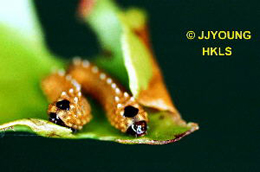
|
| 10, 2nd instar larvae - after moulting; note 1st instar larva at top just prior to moulting |
11, 3rd instar larvae |
12, 3rd instar larvae - with retractile head tucked in |
|
|
|
|
|
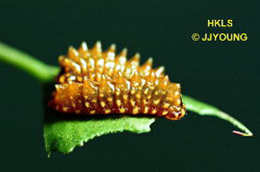
|
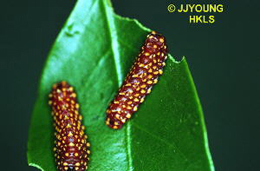
|
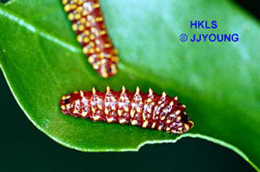
|
| 13, 3rd instar larvae - before moulting |
14, 4th instar larvae - top view |
15, 4th instar larva - side view |
|
|
|
|
|

|
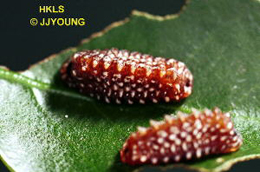
|
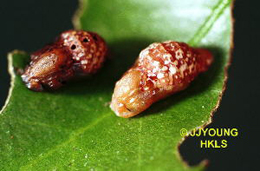
|
| 16, 4th instar larva - prior pupation, side view |
17, 4th instar larva - prior pupation, top view |
18, pupae-with left pupated an hour before the right one |
|
|
|
|
|
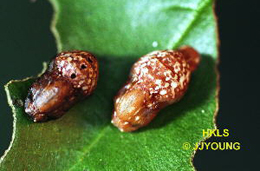
|
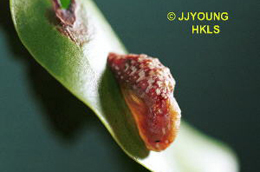
|
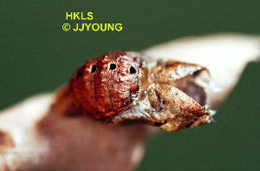
|
| 19, pupae - as above, closer-up top view |
20, pupa - side view just after pupation |
21, emptied pupa showing 4 pits on the dorsal part and 2 on the side |
|
|
|
|
|
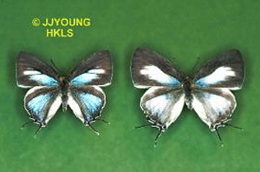
|
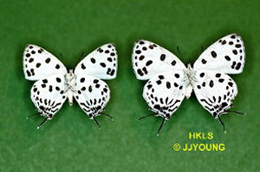
|
|
|
22, expupa male and female adult -upperside |
23, expupa male and female adult - underside |
|
(Prepared by J.J. Young)
This page was created on 15th December, 2000.
©2004 Hong Kong Lepidopterists' Society Limited
|